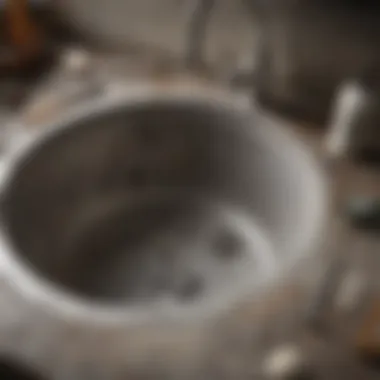Expert Tips to Fix Your Clogged Sink Garbage Disposal


Intro
Clogged sink garbage disposals are a common annoyance in many households. The modern kitchen heavily relies on the efficient functioning of these devices. When they malfunction, it can disrupt daily routines, lead to bad odors, and even cause plumbing issues. Understanding how to address these clogs can save time and money, while also maintaining a smooth operation of kitchen plumbing.
Garbage disposals can become clogged for various reasons. Food scraps, grease, and foreign objects are typical culprits. However, knowing how to troubleshoot and resolve clogs is essential for preventing future issues. This article aims to equip homeowners with practical knowledge on identifying the causes of clogged disposals and effectively resolving them.
Experiencing disposal issues is a frustrating situation that many face. With the right techniques, you can take action quickly and ensure your kitchen remains a functional space. This is not just about repair; it is also about preventing future mishaps. Now, let’s explore the potential causes of clogs and the steps needed to fix them.
Preamble to Garbage Disposal Issues
Garbage disposals are essential appliances in modern kitchens, playing a crucial role in waste management. They help homeowners minimize food waste while promoting cleanliness. However, like any other mechanical device, they can encounter issues over time. This section provides insight into the fundamental aspects of garbage disposal issues, including their role, common problems, and how understanding these can lead to effective solutions.
Understanding Garbage Disposals
A garbage disposal is a device installed under the kitchen sink. Its main function is to shred food waste into small pieces, allowing it to pass through plumbing. Understanding how these units work is vital for troubleshooting problems that may arise.
Disposals typically consist of a motor, grinding chamber, and impeller teeth. When activated, the motor spins the impeller, which effectively pulverizes food scraps. This process helps to prevent clogged sink drains.
However, despite their efficiency, garbage disposals can fail if overused or misused. Knowing how to operate them properly can minimize issues. For instance, only appropriate food materials should be introduced to the disposal. Hard or fibrous items can lead to clogs or damage.
The Importance of Maintenance
Proper maintenance of garbage disposals enhances their lifespan and performance. Regular cleaning can prevent unpleasant odors and ensure optimal functioning. An understanding of maintenance can save homeowners time and money in the long run.
Some key maintenance tips include:
- Running cold water during operation. This helps in solidifying any grease, ensuring it moves smoothly through pipes.
- Avoiding excess food scraps at one time. Feeding the unit in small batches can reduce strain.
- Periodically inspecting for foreign objects that may cause jams.
By committing to maintenance practices, homeowners can avoid many common disposal problems, keeping their kitchens functioning smoothly.
"An understanding of garbage disposals leads to effective maintenance strategies."
Common Causes of Clogs
Understanding the common causes of clogs in sink garbage disposals is crucial for effective maintenance and troubleshooting. Identifying these causes not only aids in resolving current issues but also helps prevent future occurrences. By knowing what typically leads to clogs, homeowners can take proactive measures to ensure their disposals function smoothly. Using this knowledge enhances one’s ability to manage kitchen plumbing wisely and save on potential repair costs.
Food Waste Accumulation
Garbage disposals are designed to handle food waste, but excessive accumulation can lead to blockages. Certain types of food waste are more problematic than others. Fibrous materials like celery and onion skins, as well as starchy foods such as rice and pasta, can cause the blades to jam. Gradually, this food builds up inside the disposal, restricting its efficiency.
Routine usage combined with poor disposal practices can exacerbate this issue. To mitigate food waste accumulation, it is wise to run the disposal regularly and avoid overloading it. Cutting food into smaller pieces can also help prevent clogs.
Foreign Objects
Another prevalent cause of clogged disposals involves foreign objects mistakenly entering the system. Items such as utensils, dish soap caps, or small food packaging can obstruct the grinding mechanism. Not many people pay close attention to what goes down the sink, thus leading to unexpected issues. Even small pieces of glass or plastic can cause damage or result in a complete shutdown of the unit.
To prevent this, one should always be vigilant when disposing of waste. Consider utilizing a sink strainer to filter out unwanted debris before it reaches the disposal.
Grease Buildup
Grease poses a significant challenge to garbage disposals. When fats, oils, and grease are poured down the sink, they can solidify and accumulate over time. This buildup forms a sticky barrier that hinders the proper function of the disposal. Grease can trap food particles, leading to a severe clog.


To manage grease, it is advisable to dispose of fats and oils in the trash rather than washing them down the sink. It may also be helpful to run hot water before and after using the disposal to help flush any remaining substances.
Improper Installation
Sometimes, the root cause of clogs can stem from improper installation of the garbage disposal unit itself. If the connection between the disposal and the sink is not secure, leaks and clogs can occur. Also, using incorrect plumbing materials may lead to issues that affect the disposal’s functionality.
To avoid these problems, ensure that any installation is carried out by a qualified professional or follow manufacturer guidelines meticulously. Regular checks can help detect potential installation flaws before they result in clogging issues.
Clarity on how garbage disposals work and the common trouble spots can empower homeowers to maintain their kitchen plumbing effectively.
Signs of a Clogged Disposal
Recognition of a clogged garbage disposal is crucial in maintaining the efficiency of your kitchen plumbing. Prompt action can prevent further damage and costly repairs. Early detection is key, as it allows you to address simple issues before they escalate into more significant problems. The signs of a clogged disposal can manifest in various ways, and understanding these indicators will empower homeowners to take necessary steps quickly.
Unpleasant Odors
One of the first signs of a clogged disposal is an unpleasant smell emanating from the unit. This odor usually results from decomposing food waste trapped inside the disposal. When food doesn't grind properly or when it sticks to the walls of the unit, it begins to rot. This decaying matter releases foul scents that can permeate your kitchen.
To alleviate this issue, you can try grinding citrus peels or ice cubes. Using these can help dislodge and remove residual food particles and provide a more pleasant aroma. Regular maintenance, including rinsing the disposal with hot water after use, can also help control odors effectively.
Noisy Operation
Another strong indicator of a clogged disposal is when it operates noisily. If you hear unusual sounds, such as grinding or rattling, it may signal that either foreign objects are stuck within the grinding chamber or that food waste is not being processed properly. Disposals are designed to operate quietly; thus, any deviation from this norm should prompt immediate attention.
In some cases, the noise can result from a jammed motor. Addressing the issue involves turning off the unit and inspecting the area. A solid maintenance routine can help prevent such noises from occurring. When your disposal runs quietly, it indicates that it is functioning optimally.
Water Backups
Water backups are one of the most significant signs of a clogged garbage disposal. If you notice that water is pooling in the sink or draining slowly, it means that there is an obstruction in the disposal system. This backup can hinder your sink's functionality and may lead to water damage if left unattended.
To resolve this, start by clearing visible debris from the sink and drain area. Then, press the reset button on the disposal, typically located on the bottom of the unit. This may help restore normal operation. However, if water still backs up after this initial troubleshooting, further investigation into possible blockages is necessary.
Remember: Early detection of these signs can prevent extensive damage and costly repairs, ensuring your kitchen remains functional and pleasant.
Safety Precautions Before Troubleshooting
Taking safety precautions before troubleshooting a clogged sink garbage disposal is essential for preventing accidents and ensuring an effective resolution. The disposal operates with sharp blades and electrical components, making it crucial to approach any work with care. Neglecting safety measures can lead to severe injuries or damage to the disposal unit. Emphasizing precautions protects both the individual and the appliance during the troubleshooting process.
Powering Off the Disposal
Before anything else, turning off the garbage disposal is imperative. This ensures that the blades do not inadvertently activate during inspection or repairs. Locate the power switch, often found under the sink or on the wall nearby. Most models have a dedicated switch. If unsure, unplugging the unit is a safer alternative. This step is fundamental, as it eliminates the risk of finger injuries from moving parts, allowing you to work with peace of mind.
Using Protective Gear
Wearing appropriate protective gear is another critical safety measure. Consider using sturdy gloves to protect your hands from sharp debris. Safety goggles can shield your eyes from tiny particles that may dislodge during inspection. While it might seem excessive, these precautions prevent minor injuries during what seems like straightforward tasks. Be sure to invest in quality protective gear; it is a small cost for significant safety benefits.
Avoiding Liquid Drain Cleaners
Excercising caution with liquid drain cleaners is crucial. Many homeowners reach for these products to clear clogs, but they can cause more problems than they solve. These cleaners contain harsh chemicals that can erode the inner workings of your disposal unit. Moreover, if the disposal is clogged, using these cleaners could lead to backups that create more mess. Instead, rely on safer, mechanical methods for unclogging.
"Prioritizing safety isn't just smart; it's essential when dealing with kitchen plumbing issues."
Engaging in these safety precautions establishes a proactive approach toward troubleshooting a clogged sink garbage disposal. As you begin the steps outlined, remember maintaining a safety-first mindset is vital for a successful resolution.


Essential Tools for Fixing Clogs
Fixing a clogged sink garbage disposal requires specific tools. Having the right equipment can make the process smoother and more efficient. Using inadequate tools might prolong the issue or cause additional problems. Therefore, a thorough understanding of essential tools can save time and effort. When you are equipped properly, the likelihood of resolving your garbage disposal issues increases significantly.
Wrenches
Wrenches are crucial for addressing mechanical issues within the disposal unit. They help in loosening or tightening various components. A basin wrench, for instance, is particularly useful for accessing nuts that are hard to reach. Proper maintenance is simplified with the right wrench. One should choose a wrench that suits the size of the fittings involved. Using the wrong size may strip or damage the fittings.
Plungers
Plungers are often associated with drains, but they are effective for garbage disposals as well. A plunger can help create pressure that dislodges clogs. It is vital to use a flange plunger. This type has a smaller opening, which provides better suction for kitchen drains. Be aware that plunging should not be aggressive. Too much force can damage the disposal. A gentle but firm approach is most effective in clearing minor clogs.
Flashlights
A flashlight is an essential tool for inspection. When diagnosing disposal issues, it helps to see inside the unit clearly. A good flashlight will illuminate dark spaces under the sink, allowing for a better view of potential obstructions. Bright LED flashlights are preferable because they provide better visibility. Inspecting the disposal visually can often reveal the nature of the clog or the item causing the problem.
Bucket for Water
A bucket is useful for containing water that may spill during the process. When fixing a garbage disposal, there might be residual water in the unit. If not managed properly, this water can create a mess. By placing a bucket under the sink, you can manage any spillage effectively. This tool is simple yet important. Make sure to choose a bucket that is large enough to hold the water but small enough to fit under the sink comfortably.
Step-by-Step Fixing Process
Addressing a clogged sink garbage disposal requires a systematic approach. Understanding the step-by-step fixing process is crucial because it helps you tackle the issue effectively while minimizing the chances of making the problem worse. A clear process also allows you to methodically evaluate the situation, ensuring you do not overlook any critical steps. Each stage of this procedure plays a significant role in diagnosing and resolving the issue.
Identifying the Clog Location
Begin by identifying the exact location of the clog. This can often be done by examining where the water is backing up. If the sink is draining slowly or not draining at all, there may be a build-up in the disposal unit itself or in the drain pipes leading away from it. Pay close attention to whether water accumulates in the basin or if it overflows from the disposal drain. Knowing whether the issue is localized to the disposal may change the approach you take.
Removing Visible Obstructions
Next, remove any visible obstructions that might be present. This might include leftover food particles or debris that can be easily accessed. Make sure to power off the garbage disposal before you begin. Use a pair of tongs or a similar tool to reach inside the disposal unit, as this keeps your hands safe. If you find any large pieces of waste, take them out and dispose of them in a trash bag rather than trying to grind them up. This ensures that the disposal does not become further clogged.
Using a Flashlight to Inspect
With the sink clear of visible debris, use a flashlight to inspect deeper within the disposal unit. Look for any signs of additional clogs or foreign objects that may have been missed. This inspection is essential to get a clear understanding of what might be causing the blockage. Make sure to shine the flashlight in various angles to see all parts of the disposal. Sometimes, small objects can be lodged in a way that isn't readily visible without proper lighting.
Utilizing the Manual Reset Button
If the disposal is still not operational, check the reset button, often located at the bottom of the unit. Press this button to reset the motor. Sometimes overload issues can cause the disposal to stop, and resetting it may resolve the issue. However, only do this after locating the source of the clog. If the clog persists after resetting, further investigation and removal efforts will be necessary.
Testing the Disposal After Fixing
Finally, after following the above steps, it’s time to test your disposal. Turn on the water and activate the unit again. Listen for any unusual noises or vibrations. Pay attention to how well the water drains. If everything is functioning as intended, you have likely resolved the issue. If problems persist, it may be time to consider more extensive troubleshooting or professional help.
"Taking the time to address each part of the fixing process can save you money and prevent future occurrences of clogs."
By systematically addressing the clogged disposal with this step-by-step process, you can restore its functionality. A clear understanding of how each element operates aids in effective home maintenance planning.
Preventive Maintenance Tips
Preventive maintenance is critical in ensuring that your garbage disposal functions optimally. Regular maintenance helps avoid issues before they escalate. Many homeowners overlook this aspect until a clog or malfunction occurs. Such negligence can lead to costly repairs and inconvenience. Investing time in simple maintenance tasks can keep your disposal running smoothly and extend its lifespan.
Regular Cleaning Practices


Cleaning your garbage disposal should be a routine task. Food particles can accumulate over time, leading to odors and clogs. Here are some practices to consider:
- Baking Soda and Vinegar: Periodically pour a cup of baking soda followed by a cup of vinegar into the disposal. Allow it to sit for fifteen minutes, then run hot water through the system. This natural method cleans and deodorizes.
- Ice Cubes and Salt: Grinding ice cubes mixed with salt is effective. The salt acts as an abrasive that helps to clean the blades, while the ice sharpens them as they grind.
Proper Waste Disposal Techniques
How you dispose of waste significantly affects your garbage disposal's efficiency. Be mindful of what goes down the drain. Avoid:
- Fibrous Foods: Celery, onion skins, and corn husks can tangle and cause blockages.
- Starchy Foods: Potato peels and rice expand in water, leading to clogs.
- Grease and Oils: These can solidify and build up in the disposal and plumbing.
With proper techniques, you can minimize stress on the disposal system and maintain its functionality.
Using Cold Water for Grinding
When operating your garbage disposal, always use cold water. Cold water helps solidify fats, oils, and grease, making them easier to chop up. Furthermore, it keeps the motor from overheating. Here are recommendations for using cold water:
- Keep Water Flowing: Turn on cold water before starting the disposal and keep it running for a few seconds after grinding food. This process helps flush the waste through the pipes, preventing buildup.
- Mix with Ice Occasionally: Occasionally throwing some ice into the disposal while it runs can also help keep the blades sharp and clean.
Regular maintenance is not just about cleaning but also about being informed on proper usage.
By following these preventive maintenance tips, homeowners can mitigate the risk of clogs and extend the life of their garbage disposal, ensuring their kitchen plumbing operates efficiently.
When to Call a Professional
Addressing issues with a clogged sink garbage disposal can often be handled by homeowners themselves using the right tools and techniques. However, there are situations where calling a professional is not just sensible but necessary. Knowing when to seek expert help can save time, prevent additional damage, and ensure safety.
Persistence of Clogs
If you find that clogs keep coming back after you have tried multiple fixes, this may indicate a deeper issue within your plumbing system. Persistent clogs can arise from problems such as a blockage in the pipes beyond the disposal unit or issues related to the sink's drain. These challenges are typically best handled by a professional.
It's crucial to keep in mind that repeated attempts at fixing a persistent clog might lead to further problems. This can include damaging your disposal unit or worsening the clog. Therefore, if the clog is frequent and resistant to your efforts, then it is time to bring in a professional who can assess the situation effectively.
Electrical Issues
Sometimes, the problem with a garbage disposal is not the disposal unit itself but the electrical system powering it. If you notice that your disposal is not receiving power or there are unusual sounds when you turn it on, these could be indicators of electrical issues. Potential problems can include faulty wiring, tripped breakers, or even issues with the outlet.
Handling electrical repairs can be dangerous, especially for those without experience. Electrical components are sensitive and require expertise to deal with safely. In these cases, contacting a qualified electrician or a plumber with experience in electrical problems is the best course of action.
Damaged Components
As garbage disposals age, their components can wear down, leading to problems that can't be fixed with simple maintenance. If you notice leaks, unusual noises like grinding or rattling, or an inability to grind food efficiently, the issue may stem from damaged components within the unit. This could involve the motor, blades, or seals.
Attempting to repair or replace damaged internal parts without proper knowledge can result in mistakes, which might void warranties or cause even more extensive issues. Therefore, if you suspect that your disposal has internal damage, it’s best to consult a professional. They can accurately diagnose the issues and recommend the best possible solutions without putting the unit or your plumbing at risk.
In summary, knowing when to call a professional can help you avoid further complications from ongoing clog issues, electrical failures, or damaged components in your garbage disposal.
Ultimately, while many issues can be managed independently, recognizing the limits of your expertise will help maintain the reliability and functionality of your plumbing system.
Finale
In this article, we have explored the multifaceted process of addressing a clogged sink garbage disposal. Understanding how to effectively troubleshoot and maintain this essential kitchen appliance is critical not just for convenience, but also for ensuring the longevity of the disposal system.
Summary of Key Points:
To summarize, we discussed common causes of clogs, including the accumulation of food waste, foreign objects, and grease buildup. We also emphasized the importance of maintenance practices, such as regular cleaning and proper waste disposal techniques. Additionally, the safety precautions necessary before troubleshooting, along with essential tools required for fixing clogs, were highlighted. Each of these elements contributes to a comprehensive understanding of the issues at hand.
Encouragement for Maintenance:
"A well-maintained garbage disposal not only improves kitchen hygiene but also enhances the performance of your plumbing system."
By integrating these practices into your home management routine, you can ensure that your kitchen remains a pleasant and functional space.







